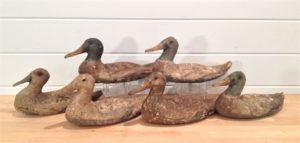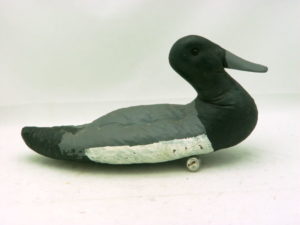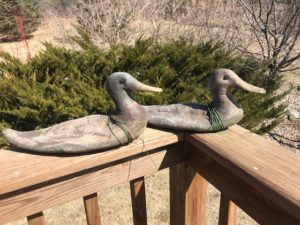In the early 1930’s decoy manufacturers were on a quest to try to reduce the weight of their decoys. Duck hunters were tired of lugging 50 pound sacks of solid wood decoys to their favorite duck hole. In previous Decoy Corner columns I discussed Carry Light and General Fibre decoys that were becoming popular because of reduced weight. Enter…Armstrong Decoys into the fray.
In 1938 in Houston, Texas, Charles L. Armstrong began to build one of the first decoys constructed of waterproofed, pre-printed cloth, sewn and stuffed with Kapok and granulated cork. Kapok was the seed fluff from a tropical tree native to Southeast Asia and Mexico. The decoys were fitted with a wooden bill insert and glass eyes. Armstrong produced mallard, pintail and bluebill species in drakes and hens. Later on in the 1940’s, black ducks, snow and Canada geese were also produced in pairs.
Very early Armstrong decoys had the Armstrong name and “patent pending” stamped on the underside of the bill. A patent was issued on November 26, 1940. All Armstrong decoys utilized a brass ring sewn on the bottom front of the decoy to use as an anchor point. Several other later manufacturers used a cloth loop as an anchor point. All Armstrong decoys have a signature heavy thread sewn through the body and anchored at the bottom.
Armstrong was in business up through 1945 and sold thousands of his decoys throughout the U.S.. Charles Armstrong’s business partner, Constant Oliveras split from Armstrong in 1941 to form his own company (Oliveras Manufacturing Co.). While Olivera’s decoys are very similar to Armstrong’s they do not have the sewn bodies like Armstrong nor the brass ring on the front, so they are easily distinguishable from each other.
According to Warman’s Duck Decoys (2006 by Russell Lewis), Armstrong Decoys are quite collectible and most decoys (Mallards) in decent shape will bring at least $125 with more unusual species (bluebills, black ducks and pintails) demanding double that value. Although some collectors have nicknamed these decoys “lady slippers” because of their unique design, they were very functional and light in the field.
Armstrong decoys are still available today in antique stores as well as auctions and garage sales. I was fortunate to be able to pick up 6
Armstrong decoys recently at a local auction for the price of a hearty breakfast. While they may not be your go-to decoy now, they sure are a storied piece of waterfowling history.



